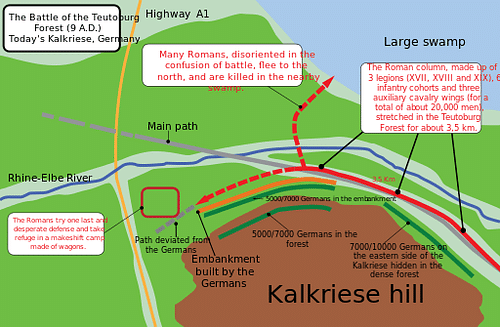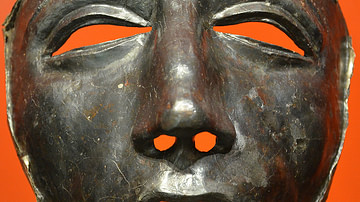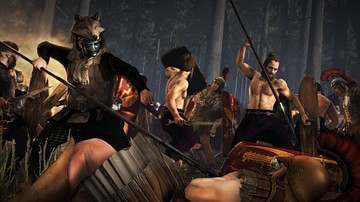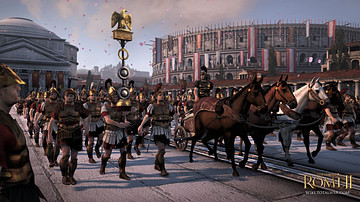At the Battle of Teutoburg Forest in 9 CE, a rag-tag barbarian force annihilated three Roman legions, leaving the Roman emperor Augustus (27 BCE to 14 CE) to nightly wander his palace, shouting for the defeated commander, Publius Quinctilius Varus, to give him back his legions. The defeat not only stopped the growth of the Roman Empire but also created the Latin-Germanic divide that persists in Western Europe to this day.
![Battle of Teutoburg Forest [Artist's Impression]](https://www.worldhistory.org/img/r/p/750x750/2255.png?v=1713913143)
Varus in Germania
In 9 CE Publius Quinctilius Varus, the first governor of the new Roman province of Germania, was departing his summer headquarters near Minden for the Roman legionary fortress of Moguntiacum (today's Mainz) when word came that a small German tribe had revolted. Revolts were nothing new to Varus; in his previous assignment as governor of Syria, he was tasked with enforcing a harsh tax regime on the locals, and as almost always happened whenever a conquered people first felt the yoke of Rome's fiscal requirements, Judea rose in revolt. Employing the Roman playbook for snuffing out insurrections, Varus rapidly marched with two of his four legions to relieve a legion trapped in Jerusalem. On his approach, the city of Sepphoris was stormed and its population sold into slavery. The visible might of the legions, coupled with examples such as Sepphoris, broke the rebels' will, and Jerusalem was surrendered without a fight, which did not stop Varus from crucifying 2,000 suspected insurgents.
Having added another successful example to the Roman playbook, Varus saw no reason to deviate from proven methods. Moving rapidly at the first sign of rebellion in Germania, he set out with the three legions at his disposal – XVII, XVIII, XIX. Unfortunately for Varus, his opponent, Arminius, was Roman-educated and -trained and, therefore, well acquainted with the Roman playbook.
Spread over ten miles and marching as if they had few concerns, the Roman column became uncharacteristically ragged and undisciplined. As the legionaries saw it, after years of campaigning by Tiberius and his brother Drusus, the Germans were a beaten people. Some of them might revolt from time to time, but few considered this any more worrisome than the sporadic revolts in Gaul after Julius Caesar's conquest. Consequently, many legionaries were wandering unarmed among the camp followers when disaster struck.
Teutoburg Forest
Rain came early on the second day's march, growing heavier as morning gave way to afternoon. Fighting against the pelting rain and lashing winds, the legionaries trudged forward in mud that brought the baggage train to a crawl. Bundled up against the elements, they became insensible to everything except their misery. Entering a narrow pass between two sections of Teutoburg Wald, the unsuspecting Romans never saw the carefully laid trap and marched into it haplessly.
Beset on all sides by missiles, the legions fell into chaos, emboldening German warriors to edge closer, hurling ever more missiles and overwhelming parts of the Roman line. Gradually but inexorably, battle-hardened centurions restored order to the wavering column as they gathered nearby legionaries to their standards, drew swords, and led counterattacks. After a ferocious fight, the first frenzied German assaults were repulsed. The Romans had bought themselves time, and Varus still had the bulk of three shaken but rapidly recovering veteran legions at hand. As the survivors constructed a fortified camp and burned their cumbersome baggage train, Varus held a council of war, which decided to march west, toward the fortified Roman base at Xanten. Even after a miserable night, the still-undaunted legions quickly smashed a gap through the German lines and headed west.

Varus, once again, played into Arminius’s hands. As the dogged legions marched into the narrow Kalkrieser-Niederweder-Senke pass, Arminius and the bulk of his German force waited behind a wall built along the pass's entire four-mile stretch. Although the Romans were again assailed from all sides, this time they were ready to meet the assault. However, instead of offering a head-to-head clash, the Germans stayed behind the cover of their protective walls, hurling missiles by the thousands. Most of the Romans hunkered down behind their shields while some cohorts, unwilling to remain passive targets, advanced on the German positions. Most of these unsupported assaults were easily repulsed, but others broke through, only to be cut down by the thousands of Germans waiting beyond the walls.
As Roman cohesion began to collapse, Arminius unleashed his massed warriors on the faltering legions. Thousands fell as each side hacked at the other with sword and ax. German losses must have been greater, but they were continuously reinforced throughout the day, while the Romans, still a hundred miles distant from their fortress, despaired of help.
The remains of the Roman column retreated west, probably toward Osnabrück, and camped upon a nearby hill for the night. Lacking the energy to fortify their camp, the legionaries huddled against the elements and a growing tide of barbarians. Their gloom increased when it became known that the cavalry had deserted and Varus had committed suicide. On the fourth day, they were again ambushed in a wooded area, and by noon it was all over. After a four-day running fight, the Germans had obliterated three legions. The Roman survivors were tortured before being hanged or burned alive. Their heads were nailed to trees or the skulls taken home as souvenirs.
Aftermath
Six years later Germanicus, at the head of a new Roman army seeking vengeance, revisited the battle site. Tacitus recorded the event:
In the plain between were bleaching bones, scattered or in little heaps, as the men had fallen, fleeing or standing fast. Hard by lay splintered spears and limbs of horses, while human skulls were nailed prominently on the tree-trunks. In the neighboring groves stood the savage altars at which they had slaughtered the tribunes and chief centurions.
In a virtual instant, Roman power east of the Rhine vanished, and two decades of Roman efforts to subdue Germania lay in ruins. Distraught over the collapse of his policy and the irreplaceable loss of three of the Roman Empire's 28 legions, Augustus went into mourning, tore his clothes, and let his hair and beard grow. As he walked through the halls of his residence, ancient sources claim, from time to time he would stop and hit his head against a wall, wailing, "Varus, give me back my legions."






